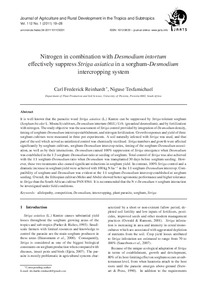| dc.date.accessioned | 2012-01-17T10:38:34Z | |
| dc.date.available | 2012-01-17T10:38:34Z | |
| dc.date.issued | 2011 | |
| dc.identifier.issn | 1612-9830 | |
| dc.identifier.uri | urn:nbn:de:hebis:34-2011101139331 | |
| dc.identifier.uri | http://hdl.handle.net/123456789/2011101139331 | |
| dc.language.iso | eng | |
| dc.publisher | Kassel University Press | ger |
| dc.rights | Urheberrechtlich geschützt | |
| dc.rights.uri | https://rightsstatements.org/page/InC/1.0/ | |
| dc.subject | allelopathy | eng |
| dc.subject | competition | eng |
| dc.subject | Desmodium | eng |
| dc.subject | intercropping | eng |
| dc.subject | plant parasite | eng |
| dc.subject | sorghum | eng |
| dc.subject | Striga | eng |
| dc.subject.ddc | 630 | |
| dc.title | Nitrogen in combination with Desmodium intortum effectively suppress Striga asiatica in a sorghum‒Desmodium intercropping system | eng |
| dc.type | Aufsatz | |
| dcterms.abstract | It is well known that the parasitic weed Striga asiatica (L.) Kuntze can be suppressed by Striga-tolerant sorghum (Sorghum bicolor L. Moench) cultivars, Desmodium intortum (Mill.) Urb. (greanleaf desmodium), and by fertilization with nitrogen. The study objective was the assessment of Striga control provided by integration of Desmodium density, timing of sorghum-Desmodium intercrop establishment, and nitrogen fertilization. Growth responses and yield of three sorghum cultivars were measured in three pot experiments. A soil naturally infested with Striga was used, and that part of the soil which served as uninfested control was chemically sterilised. Striga numbers and growth were affected significantly by sorghum cultivars, sorghum-Desmodium intercrop ratios, timing of the sorghum-Desmodium association, as well as by their interactions. Desmodium caused 100% suppression of Striga emergence when Desmodium was established in the 1:3 sorghum-Desmodium ratio at seeding of sorghum. Total control of Striga was also achieved with the 1:1 sorghum-Desmodium ratio when Desmodium was transplanted 30 days before sorghum seeding. However, these two treatments also caused significant reductions in sorghum yield. In contrast, 100% Striga control and a dramatic increase in sorghum yield were achieved with 100 kg N ha^{-1} in the 1:1 sorghum-Desmodium intercrop. Compatibility of sorghum and Desmodium was evident at the 1:1 sorghum-Desmodium intercrop established at sorghum seeding. Overall, the Ethiopian cultivars Meko and Abshir showed better agronomic performance and higher tolerance to Striga than the South African cultivar PAN 8564. It is recommended that the N × Desmodium × sorghum interaction be investigated under field conditions. | eng |
| dcterms.accessRights | open access | |
| dcterms.bibliographicCitation | In: Journal of Agriculture and Rural Development in the Tropics and Subtropics. Kassel : Kassel University Press. - Vol. 112, No. 1 (2011), S. 19-28 | |
| dcterms.creator | Reinhardt, Carl Frederick | |
| dcterms.creator | Tesfamichael, Niguse | |
| dc.description.everything | Gedruckte Ausg. im Verlag Kassel Univ. Press (www.upress.uni-kassel.de) erschienen. | ger |

